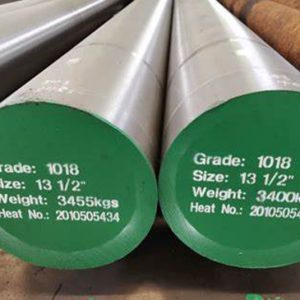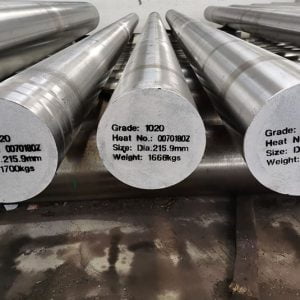Welcome to My Blog!
Before we dive into the content, I’d love for you to join me on my social media platforms where I share more insights, engage with the community, and post updates. Here’s how you can connect with me:
Facebook:https://www.facebook.com/profile.php?id=100087990137347
LinkedIn:https://www.linkedin.com/company/89825762/admin/dashboard/
YouTube:www.youtube.com/@carbonsteelsupply-kj9lw
TikTok:www.tiktok.com/@carbonsteelsupply
Now, let’s get started on our journey together. I hope you find the content here insightful, engaging, and valuable.
Einführung
Steel 1018 is one of the most commonly used grades of carbon steel due to its excellent machinability, weldability, and ease of fabrication. It is widely used in various industries, including automotive, construction, and manufacturing. Whether you are a seasoned engineer or someone new to the world of metallurgy, understanding the properties of steel 1018 is crucial for selecting the right material for your project. In this guide, we will delve into the key properties of steel 1018, its applications, and why it is a preferred choice in many industries.
What is Steel 1018?

Steel 1018 is a low-carbon steel with a carbon content of approximately 0.18%. It is classified as a mild or low-carbon steel, which means it has lower carbon content compared to medium and high-carbon steels. This characteristic gives steel 1018 its desirable properties, such as good formability and weldability, making it suitable for a wide range of applications.
Composition of Steel 1018:
- Carbon (C): 0.15% – 0.20%
- Manganese (Mn): 0.60% – 0.90%
- Phosphorus (P): 0.040% max
- Sulfur (S): 0.050% max
The composition of steel 1018 ensures a balance of strength, ductility, and ease of machining, which are critical factors in manufacturing and fabrication processes.
Key Properties of Steel 1018
Understanding the properties of steel 1018 is essential for determining its suitability for different applications. These properties include mechanical properties, machinability, weldability, and heat treatment capabilities.
Mechanical Properties
Steel 1018 offers a combination of mechanical properties that make it a versatile material for various applications. These properties include tensile strength, yield strength, elongation, and hardness.
- Tensile Strength: Steel 1018 has a tensile strength of approximately 440 MPa (64,000 psi), which provides adequate strength for many structural and mechanical applications.
- Yield Strength: The yield strength of steel 1018 is around 370 MPa (54,000 psi), indicating the stress at which the material begins to deform plastically.
- Elongation: Steel 1018 has an elongation of about 15% in 2 inches, which reflects its ductility and ability to undergo plastic deformation before fracture.
- Hardness: The Brinell hardness of steel 1018 is typically around 126 HB, indicating moderate hardness suitable for machining and forming.
Machinability
One of the standout features of steel 1018 is its excellent machinability. It can be easily machined using standard machine tools, making it a popular choice for manufacturing precision parts and components.
- Machinability Rating: Steel 1018 has a machinability rating of approximately 70% compared to AISI 1212, which is the standard for 100% machinability.
- Surface Finish: The material allows for a smooth surface finish, which is crucial for parts that require tight tolerances and high-quality finishes.
- Tool Wear: Steel 1018 causes minimal tool wear, making it cost-effective for high-volume production runs.
Weldability
Steel 1018 is highly weldable, making it suitable for various welding processes, including MIG, TIG, and arc welding. Its low carbon content minimizes the risk of weld cracking and other welding defects.
- Preheat Requirements: Generally, no preheat is required for welding steel 1018, although preheating may be necessary for thicker sections to prevent thermal stress.
- Post-Weld Treatment: Post-weld heat treatment is not typically required for steel 1018, but it can be performed to relieve residual stresses or improve mechanical properties.
Wärmebehandlung
Steel 1018 responds well to various heat treatment processes, which can be used to alter its mechanical properties for specific applications.
- Annealing: Annealing is performed at 870°C (1600°F) followed by slow furnace cooling to improve ductility and reduce hardness.
- Normalizing: Normalizing is done at 900°C (1650°F) followed by air cooling, which refines the grain structure and improves mechanical properties.
- Hardening: Steel 1018 can be hardened by quenching in water or oil after heating to 780-820°C (1436-1508°F), followed by tempering to achieve the desired hardness and toughness.
Table: Comparison of Steel 1018 Properties with Other Carbon Steels
| Eigentum | Steel 1018 | Steel 1045 | Steel 4140 |
|---|---|---|---|
| Carbon Content | 0.18% | 0.45% | 0.40% |
| Zugfestigkeit | 440 MPa (64,000 psi) | 585 MPa (85,000 psi) | 655 MPa (95,000 psi) |
| Streckgrenze | 370 MPa (54,000 psi) | 415 MPa (60,000 psi) | 415 MPa (60,000 psi) |
| Machinability | 70% | 60% | 50% |
| Weldability | Excellent | Good | Fair |
| Hardness (Brinell) | 126 HB | 170 HB | 197 HB |
| Wärmebehandlung | Responds well to annealing, normalizing, hardening | Hardens well, responds to quenching and tempering | Excellent hardening, suitable for heat treatment |
This table compares the properties of steel 1018 with other common carbon steels, such as steel 1045 and steel 4140. It highlights the differences in carbon content, mechanical properties, machinability, weldability, and heat treatment capabilities.
Applications of Steel 1018

Steel 1018 is used in a wide range of applications across various industries due to its versatility and favorable properties. Here are some of the common uses of steel 1018:
Autoindustrie
- Steel 1018 is frequently used in the automotive industry for the production of components such as shafts, gears, and axles. Its excellent machinability and weldability make it ideal for manufacturing precision parts.
Bauwesen
- In the construction industry, steel 1018 is used for making structural components, fasteners, and anchors. Its moderate strength and good weldability make it suitable for various construction applications.
Machinery and Equipment
- Steel 1018 is widely used in the manufacturing of machinery parts, including bushings, pins, and rods. Its ability to be easily machined and formed makes it a popular choice for custom parts and components.
Tools and Dies
- Although not as hard as tool steels, steel 1018 can be used for making simple tools and dies, especially when combined with surface treatments or case hardening to enhance its surface hardness.
Furniture and Fixtures
- Steel 1018 is also used in the production of furniture and fixtures, particularly where a smooth finish and ease of fabrication are required. It is commonly found in items such as frames, supports, and brackets.
Schlussfolgerung
Steel 1018 is a versatile and widely used low-carbon steel that offers a balanced combination of machinability, weldability, and mechanical properties. Its ease of use and adaptability make it an ideal choice for various industries, including automotive, construction, and manufacturing. By understanding the properties and applications of 1018 steel, you can make informed decisions when selecting materials for your projects, ensuring optimal performance and cost-effectiveness. Whether you’re manufacturing precision parts or constructing structural components, steel 1018 provides the reliability and flexibility needed to meet your needs.
FAQ
What makes 1018 steel different from other low-carbon steels?
1018 steel is known for its excellent machinability, weldability, and ease of fabrication, making it a preferred choice for many applications. Its balanced combination of properties sets it apart from other low-carbon steels.
Can 1018 steel be heat-treated to improve its properties?
Yes, 1018 steel can be heat-treated through processes such as annealing, normalizing, and hardening to alter its mechanical properties, such as hardness, strength, and ductility.
Is 1018 steel suitable for high-stress applications?
While 1018 steel offers moderate strength, it may not be the best choice for high-stress applications where higher strength or hardness is required. In such cases, higher carbon steels or alloy steels may be more appropriate.
How does the machinability of 1018 steel compare to other steels?
1018 steel has a machinability rating of approximately 70%, which is higher than many other carbon steels, making it easier to machine and ideal for producing precision parts.
What are the common welding techniques used with 1018 steel?
Common welding techniques for 1018 steel include MIG, TIG, and arc welding. Its low carbon content reduces the risk of weld cracking, making it suitable for various welding applications.
Can 1018 steel be used in cold forming processes?
Yes, 1018 steel is well-suited for cold forming processes due to its good ductility and formability. It can be easily bent, stamped, and drawn into various shapes.
What surface treatments are commonly applied to 1018 steel?
Surface treatments such as galvanizing, painting, and plating are commonly applied to 1018 steel to enhance its corrosion resistance and improve its surface appearance.
How does 1018 steel perform in corrosive environments?
1018 steel has limited corrosion resistance, especially in harsh environments. It is often coated or treated to improve its resistance to rust and corrosion.
What are the alternatives to 1018 steel for higher strength applications?
Alternatives to 1018 steel for higher strength applications include steels like 1045, 4140, and alloy steels, which offer higher tensile and yield strengths.
Is 1018 steel suitable for use in the aerospace industry?
1018 steel is generally not used in the aerospace industry due to its moderate strength and lack of specialized properties required for aerospace applications. Instead, high-strength alloy steels and aluminum alloys are commonly used.





